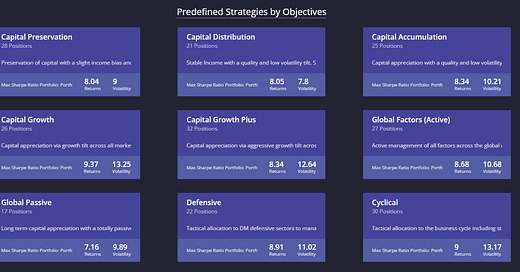A Comprehensive Assessment of an Investor’s Risk Profile by Lumen R4A
A Multi-Efficiency Frontiers Approach

In our article “A Path to Individual Investor Wealth”, we pointed out portfolios are first risk management tools and second investment vehicles. This means before even considering investing, we need to define clearly our risk targets (investment objectives), whether quantitative or qualitative.
Lumen R4A portfolio construction does not start by asking a few risk profiling questions and then classifying investors into three typical risk buckets: conservative, moderate, and aggressive, and creating portfolios based on volatility, i.e. we do not view volatility as risk. Instead, we enable investors to calibrate and personalize an infinite number of portfolios by clearly defining the investment strategy first -- whether the investor is seeking income, capital appreciation, growth, etc. Each portfolio contains attributes that match the investment strategy and objective.
Lumen R4A’s risk assessment framework is a holistic approach based on the CFA Institute (CFA’s Institute Investment Risk Profiling: A Guide for Financial Advisors) supported by inputs from UC Berkeley's behavioral research on financial risk-taking. We posit that the investor’s risk profile should be determined holistically by combining three dimensions of risk: objective, behavioral, and capacity.
I. Investment Objective. Establish need and strategy. This is possibly the most relevant piece of individual information and the starting point for building a portfolio. Investors’ objectives can be qualitative (e.g. capital distribution, capital preservation, or growth) or quantitative (a specific need, for example, a 10% return, $100,000 yearly cash flow, $2 million in 15 years starting with $1 million today). The targeted number ought to be reasonable and consistent or a function of what is possible in current markets. By asking the investment objective and a series of questions including investment horizon, net cash flow, expected inflation rate, and initial and final portfolio value, we can derive the investor’s required rate of return, which can be assessed against the current/expected market conditions (returns). Then, the system provides the appropriate investment universe and a set of risk solutions fitting the investors’ needs (their Efficient Frontier).

II. Behavioral (Risk Tolerance). Identify the psychological and behavioral reaction to adverse financial events e.g., a noticeable market decline. We adopt Finametrica’s (risk tolerance expert) scientifically researched psychometric[1] risk profiling questionnaire with 25 questions. Comprehensive behavioral risk tolerance involves assessing the investor’s risk tolerance, preference, composure, perception, and investing experiences. The result is a granular classification of risk tolerance from 0 to 100% that allows Lumen to calibrate more precisely the suggested portfolio across the 5 risk buckets: Low, Conservative, Moderate, High, and Aggressive

III. Capacity. Uncover how much the investor has available to invest … or lose it all. This is an often-overlooked element. Based on the investor’s investment horizon, liquidity needs (e.g., yearly withdrawal), other income, and total liquid assets as a percentage of net worth, we can establish the investor’s risk capacity, which helps to gauge how much decline in portfolio values the investor can withstand without adversely impacting their current living standard. Conceptually, an amount available for investments equivalent to 100% of liquid wealth has little risk capacity; an amount equivalent to 10% has a substantial risk capacity.
From Risk Profiling to Creating a Robust and Customized Portfolio
We review the inputs to the investment objective, risk tolerance, and capacity and check if the answers provided are consistent and coherent before recommending a universe and portfolio. For example, it makes no sense to be classified as a moderate investor, invest 100% of the liquid wealth (high risk), and have ambitious return targets (high risk); e.g., a moderate investor, investing $1 million (100% of wealth), targeting $2 million in 8 years, or ~10% return (high risk and high need), plus an annual cash withdrawal (high needs).
The system automatically provides feedback if the investors’ answers are consistent or not and allows them (or their financial advisors) to review and edit their inputs. Importantly, inconsistencies reflect a trigger of our risk profiling rules when we evaluate an investor’s risk: (1) The Risk Tolerance result sets the baseline riskiness of the portfolio. (2) The Risk Capacity result sets the upper limit on how aggressive the universe/portfolio can be. Inconsistencies across the risk elements often lead to poor asset allocation and portfolio construction, contributing to disastrous outcomes irrespective of market results.
The intersection of these three risk answers therefore determines the type of markets and asset classes (investment universe) and the risk/return tradeoff suited for the investor, e.g., only Developed, some Emerging, alternatives, growth, etc., a set of portfolio solutions reflecting different risk-return trade-offs, and the recommended portfolio based on the investor’s goal, needs, and risk profile. Investors can further calibrate their final portfolio weights, investment constraints, risk levels, and expected returns.
Summarizing: Multi-Efficiency Frontiers Approach
To reiterate, Lumen does not believe in a “one-size-fits-all” portfolio allocation approach, i.e. using the same investment universe and adapting to all types of investors and then calibrating the risk by dialing up and down the low-risk (cash) components of the set of investment alternatives. This often leads to an inefficient asset allocation, loss of opportunities and, ultimately, unnecessary risk.
Instead, Lumen adopts a “Multi-Efficiency Frontiers” approach. We first help the investor determine an appropriate investment universe, selecting amongst predefined sets of asset classes, markets, sectors, factors, etc. classified by objectives (and therefore strategies), each resulting in a specific, separate Efficient Frontier. Then calibrate the allocation further by selecting allocation across the Efficient Frontier most closely reflecting the risk tolerance and capacity of the individual investor … i.e., a truly customized investment solution.
[1] Psychometrics is an amalgam of psychology and statistics that can quantify and assess psychological traits and constructs. Psychometrics is well-established and accepted science, with validation tools to determine the technical quality of psychological assessment tools such as questionnaires.



